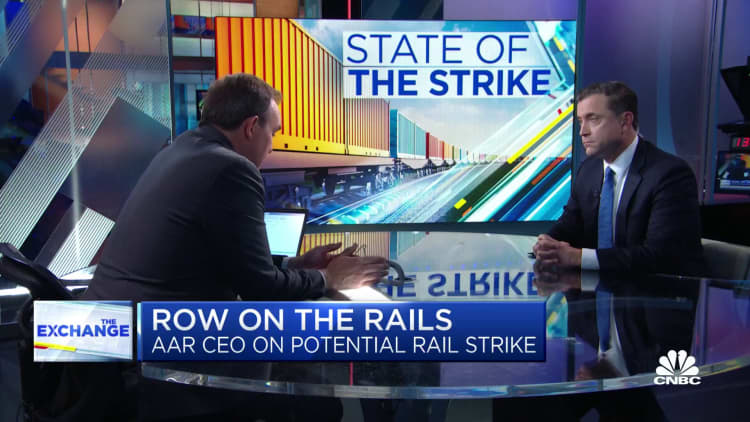
The strike prep calendar for rail operators, customers, and logistics managers continues to be in flux with a lack of coordination between key rail unions leaving open the potential for two strike dates in December.
BMWED, which represents the Brotherhood of Maintenance of Way Employees, is scheduled to strike on December 5 with the The Brotherhood of Railroad Signalmen (BRS). But BMWED announced it would extend its cooling-off period if one of the larger unions — the Transportation Division of the International Association of Sheet Metal, Air, Rail, and Transportation Workers (SMART-TD) and the Brotherhood of Locomotive Engineers and Trainmen (BLET) — votes not to ratify the tentative labor deal. Those key votes will be announced next Monday.
But unlike BMWED, the BRS — which can also strike after its cooling-off period ends on Dec. 4 — has not indicated whether it will extend its deadline for talks.
BRS did not respond to CNBC’s multiple requests for an update on its negotiation timeline and if it was considering an alignment with the other unions.
According to federal safety measures, railroad carriers begin prepping for a strike seven days before the strike date. The carriers start to prioritize the securing and movement of security sensitive materials like chlorine for drinking water and hazardous materials in the rail winddown.
96 hours before a strike date, chemicals are no longer transported. According to the American Chemistry Council, railroad industry data shows a drop of 1,975 carloads of chemical shipments during the week of September 10 when the railroads stopped accepting shipments due to the threat of a strike.
The Association of American Railroads would be expected to release its planning steps, similar to what it announced in September, after the final votes are in, and if the cooling-off period of BRS changes.
CSX Transportation freight trains sit parked in a railroad yard in September during the initial threat of a potential freight rail workers union strike.
The Washington Post | The Washington Post | Getty Images
Here’s a breakdown of how the complicated situation, which is a serious risk to the U.S. economy, GDP growth, and inflation, could play out in the days and week ahead.
Outcome No. 1
If one of the two unions votes against ratification on Monday, the cooling-off period clock is reset until Dec. 8 and a strike could begin on Dec. 9. BMWED would then join BLET and the SMART-TD. But, if the BRS does not move its schedule to align with the other unions, a strike would start on December 5.
Based on the September strike prep guidelines, if there is a strike on Dec. 5, strike preps are expected to begin November 28, the day the Senate arrives back from Thanksgiving break. The House is back on the Hill on November 29.
Some industry groups have urged Congress, which has authority under the Railway Labor Act, to act to prevent a strike.
Outcome No. 2
If the BRS decides to join BMWED and extends its cooling-off period, to match the larger union’s timeline, strike preps would begin on December 1.
Outcome No. 3
If the BLET and SMART-TD unions vote to ratify the tentative deal, the BMWED and the BRS could strike on December 5.
The difference between the four days may seem negligible, but planning needs to be put in place on how to move rail-bound products to alternative logistics.

UPS is the rails’ largest customer.
A UPS spokesperson told CNBC, “We encourage an immediate resolution that is beneficial to all parties and we believe that agreements can be reached. A railway strike would cause unnecessary impacts on the U.S. economy and consumers. UPS will flex our integrated smart logistics network to serve our customers.”
Jon Gold, vice president of supply chain and customs policy of the National Retail Federation, told CNBC it remains concerned about the potential for a rail strike in the coming weeks, citing supply chain disruptions that would create more inflationary pressures.
“A rail strike in December would potentially impact holiday goods, as well as shipments for spring merchandise that retailers are already starting to bring in,” Gold said. “We hope the freight railroads and rail labor organizations will resolve the contract issue without engaging in a strike or disruption. Otherwise, Congress must quickly intervene to ensure a disruption does not occur.”
A recently released economic analysis by the American Chemistry Council estimates that a rail strike would impact approximately $2.8 billion in chemical cargo that is moved weekly, with a month-long strike resulting in an overall hit to the economy of $160 billion, or one percentage point of GDP, and rise in a key inflation index, the Producer Price Index, of 4%.
The ACC represents companies across industrial, energy and pharmaceutical sectors, among other manufacturing niches, including 3M, Dow, Dupont, Exxon Mobil, Chevron, BP and Eli Lilly.
The ACC is among the groups urging Congress to step in, using the authority it has to impose a deal under the Railway Labor Act.
 EU News Digest Latest News & Updates
EU News Digest Latest News & Updates



